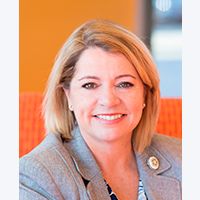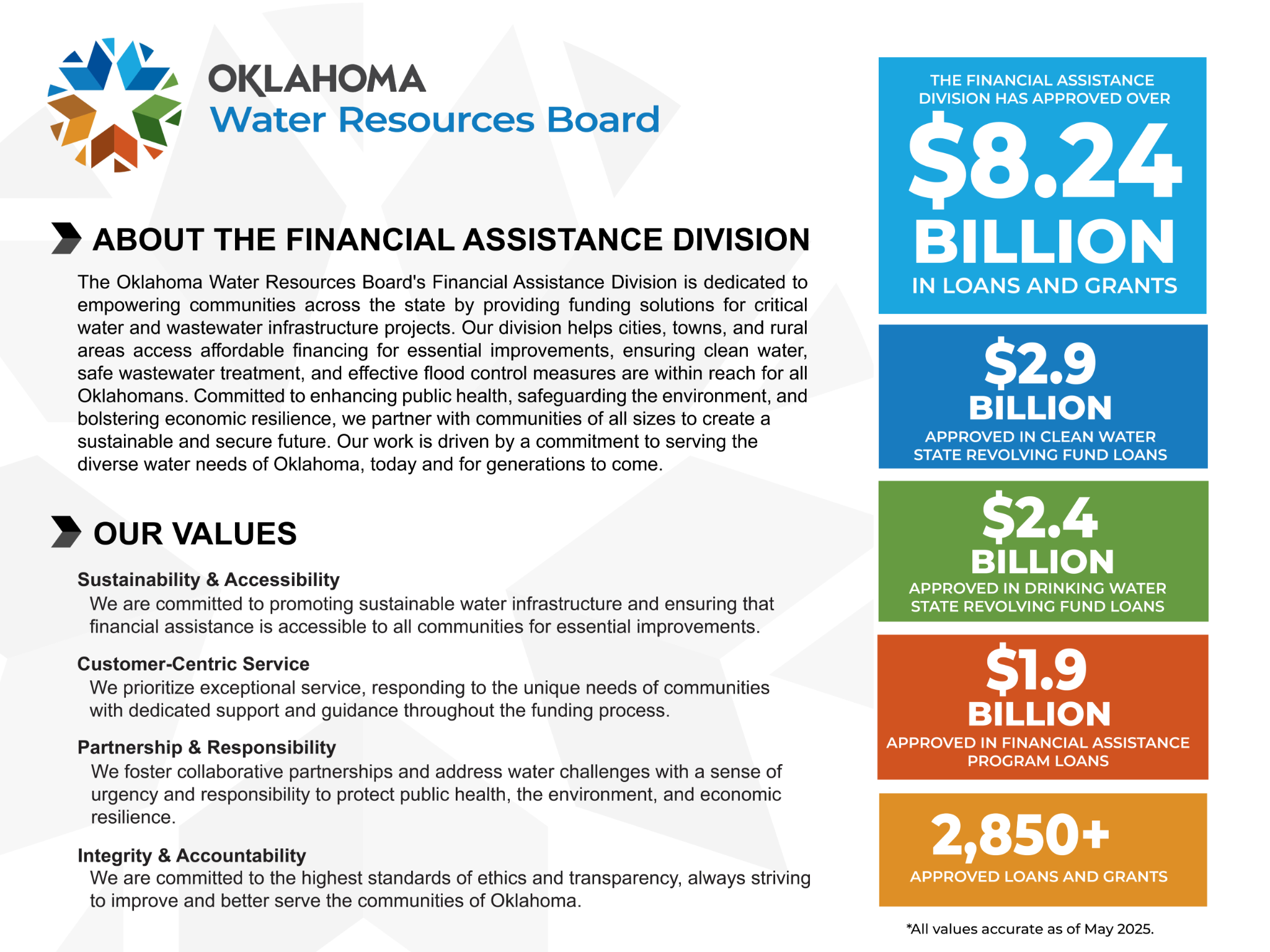Bond Programs
Lori Johnson, Chief, Financial Assistance Division
Oklahoma Water Resources Board
Oklahoma Water Resources Board
Learn about Oklahoma Water Resources Board including our News & Press Releases, Projects, and Team.
Have questions? Reach out to us directly.
Learn about Oklahoma Water Resources Board including our News & Press Releases, Projects, and Team.
The OWRB's mission is to protect and enhance the quality of life for Oklahomans by managing and improving the state’s water resources to ensure clean and reliable water supplies, a strong economy, and a safe and healthy environment.
Our primary duties and responsibilities include water use appropriation and permitting, water quality monitoring and standards, financial assistance for water/wastewater systems, dam safety, floodplain management, water supply planning, technical studies and research, and water resource mapping.
The Clinton Public Works Authority Receives $5,390,000 Loan for Wastewater System Improvements from the OWRB
OKLAHOMA CITY – The Clinton Public Works Authority (Authority) received approval for a $5,390,000 Financial Assistance Program (FAP) loan on Tuesday from the Oklahoma Water Resources Board (OWRB) to improve their wastewater infrastructure.
The Authority, located in Custer County, operates the community’s public wastewater system, serving more than 3,300 sewer connections. The Authority’s main sewer line—which carries wastewater to the treatment plant—has experienced structural failure and no longer meets regulatory standards, requiring timely replacement to protect system reliability and public health. The proposed project includes constructing a new lift station equipped with bar screens, which remove debris from wastewater, and installing a new force main to convey flows to the treatment plant. The project also includes building a new splitter box to safely direct incoming wastewater from multiple lines and adding a new manhole to improve system access and flow management. Together, these improvements will restore compliance, strengthen critical infrastructure, and ensure dependable wastewater service for residents and businesses.
According to Lori Johnson, chief of the OWRB’s Financial Assistance Division, the Authority’s customers will save an estimated $1,338,500 compared to traditional financing. The loan shall be secured with a lien on the revenues of the Authority’s water and sewer services, a 3 cent sales tax, and will include a mortgage on the water and sewer systems.
Harper County Rural Water District No. 1, Harper County, Oklahoma Receives $56,029 Grant for Water System Improvements from the OWRB
OKLAHOMA CITY – The Harper County Rural Water District No. 1, Harper County, Oklahoma (District) in Harper County received approval for a $56,029 Emergency Grant on Tuesday through the Oklahoma Water Resources Board (OWRB) to improve the District’s Water infrastructure.
The District operates a public water system serving rural customers in Harper County. Earlier this year, the District experienced a complete loss of water pressure when an air pocket entered the main line and became trapped at the system’s highest point during unrelated construction work. To quickly restore service and protect public health, the District installed an emergency connection to the Town of Buffalo’s water system, including approximately 400 feet of new high-density polyethylene (HDPE) waterline and related components. The total project cost was $65,916, with $56,028.60 eligible for reimbursement through the OWRB Emergency Grant. The remaining $9,887.40 in local funds fulfills the required 15% grant match.
Lori Johnson, chief of the OWRB's Financial Assistance Division, calculated that the grant will save the Authority’s customers $175,900 in principal and interest charges by not having to borrow the project funds.
The Collinsville Municipal Authority Receives $2,270,000 Loan for Water and Wastewater System Improvements from the OWRB
OKLAHOMA CITY – The Collinsville Municipal Authority (Authority) received approval for a $2,270,000 Financial Assistance Program (FAP) loan on Tuesday from the Oklahoma Water Resources Board (OWRB) to improve their water and wastewater infrastructure.
The Authority, located in Tulsa County, operates the community’s public water and wastewater systems, serving more than 2,200 water connections and 2,900 sewer connections. As Collinsville continues to grow, the Authority is expanding its infrastructure to support new development and maintain reliable service. The funds will be used to connect a planned expansion area to the existing wastewater system through a new lift station and force main and will extend water service through a shared infrastructure improvement with local partners. These improvements support the Turner project, a 154-acre development located at the southeast corner of 136th Street North and Highway 169. The work includes constructing a lift station, installing a 4,070-foot 6-inch force main, and extending a 12-inch water line in coordination with Washington County Rural Water District #3.
According to Lori Johnson, chief of the OWRB’s Financial Assistance Division, the Authority’s customers will save an estimated $573,000 compared to traditional financing. The loan shall be secured with a lien on the revenues of the Authority’s water, sewer, and electric services, and a $1.75 cents sales tax.

The Oklahoma Water Resources Board's (OWRB) Financial Assistance Division assists communities in their efforts to protect and conserve Oklahoma's water resources for current and future generations through cost-effective financial products, technical assistance, and high quality customer service. To find more information, please visit here.
Loan Programs:
The CWSRF loan program is funded by EPA capitalization grants, state matching funds, and bonds. The CWSRF is administered by the OWRB. The interest rate is approximately 60% of AAA market rate with 40% savings through federal subsidy.
The DWSRF loan program is funded by EPA capitalization grants, state matching funds, loan repayments, investment earnings, and bonds. The DWSRF is co-administered by the OWRB and the Oklahoma Department of Environmental Quality (ODEQ). The interest rate is approximately 70% of AAA market rate with 30% savings through federal subsidy.
The OWRB's state loan revenue bond program offers long term, variable interest rate funding with a fixed rate conversion option. This low interest rate is based on the OWRB's AAA credit rating.
Grant Programs:
The Emergency Grant Program is a point-based program designed to assist communities facing crises which threaten life, health, or property.
The REAP Grant Program is a point-based program designed to assist smaller communities that lack sufficient fiscal capacity. Cities, towns, and municipalities with a population less than 1,750 are given priority. Rural water and/or sewer districts with less than 525 non-pasture customers are also given priority.

Have questions? Reach out to us directly.